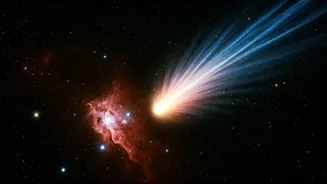What Is 3I/ATLAS?
The discovery of 3I/ATLAS marked a significant moment in astronomical observation. It was identified as an interstellar comet, a celestial body that originated
outside our solar system. This classification was based on its trajectory and speed, confirming its origin from beyond our Sun's influence. Unlike comets originating within our solar system, 3I/ATLAS provided a rare opportunity to study material formed in a different star system. Its journey through our celestial neighborhood offered valuable insights into the composition and characteristics of other planetary systems. The study of 3I/ATLAS sparked significant interest and research, as scientists sought to unravel its secrets and understand its place in the cosmic tapestry. As it traversed the solar system, it became a focal point for observation, analysis, and a treasure trove of information about the universe.
Journey's Path & Speed
The path and speed of 3I/ATLAS offered crucial clues to its interstellar origin. Unlike comets born within our solar system, this object's trajectory exhibited a hyperbolic path, indicating it was not bound to the Sun's gravity. Its speed was another key indicator; it entered our solar system at a velocity far exceeding that of typical solar system comets. These factors confirmed its origin from interstellar space, highlighting its journey through the vast expanse of the galaxy. Its incredible velocity provided further evidence, allowing astronomers to trace its origins, helping them map its path across the cosmos. Analyzing its movement was crucial for understanding its journey, and helping astronomers unravel its past and potential future. Understanding the velocity was essential to calculate its trajectory through the galaxy, offering vital insights into its birthplace and the circumstances of its long, interstellar voyage.
Size, Age, Composition
Analyzing 3I/ATLAS’s size, age, and composition was key to understanding its nature. The comet's size, initially estimated from its brightness, helped scientists calculate its overall mass and surface area, providing clues about its structural integrity. Determining its age, though challenging, involved studying the material it emitted, such as gas and dust, to estimate when this object first formed. Spectroscopic analysis provided critical insights into its composition. By studying the light the comet reflected and emitted, scientists were able to identify the elements and molecules present in its nucleus, revealing the building blocks from which the comet was made. This composition analysis included ice, dust, and organic compounds, similar to those found in other comets and asteroids, but also some interesting distinctions, giving clues about its formation environment and journey through space.
Unusual Activity Noted
During its journey, 3I/ATLAS exhibited intriguing and unexpected behavior. It displayed jets, streams of gas and dust ejected from its surface. These jets, visible through telescopes, indicated localized areas of increased activity. The comet also developed a tail, a characteristic feature of comets formed due to the solar wind's effect on its volatile material. In addition to these standard traits, 3I/ATLAS showed signs of water leakage, a critical factor for analyzing a comet's internal structure and chemical processes. These behaviors provided essential data about its internal composition, exposing volatile substances to the heat of the sun. The study of this activity was essential to understanding the comet's dynamic processes and how the material from the outer reaches of the solar system interacts with the environment.
Comet, Asteroid, Or…?
Classifying 3I/ATLAS presented a challenge, as it showed characteristics of both comets and asteroids. While its activity suggested it was cometary, its physical composition held asteroid-like characteristics. The primary identifier that classified it was the presence of a coma and tail, usually seen in comets, supporting the idea of a comet. However, its other features made it difficult to classify it in simple terms. Despite these challenges, the ability to study 3I/ATLAS provided valuable insights into the diversity of space objects and the formation of celestial bodies, challenging pre-conceived notions. This examination helped in understanding the differences and similarities between comets and asteroids, and provided scientists the opportunity to redefine and refine their classification methods based on its data.
Controversy & Speculation
The arrival of 3I/ATLAS sparked both excitement and speculation among scientists. One area of debate was whether it was natural or had been altered. Some researchers suggested that the comet's composition and behavior were unusual compared to other comets in our solar system, leading to several hypotheses. These range from the possibility of it being a remnant of planet formation from outside of our solar system, to the suggestion of a different type of celestial body. These speculations reflect the scientific community's interest in understanding the universe. The controversy highlights the ongoing scientific process, in which observations and studies contribute to constant refinement and re-evaluation. The study of 3I/ATLAS therefore has offered valuable insight, pushing the limits of our cosmic comprehension.
Observing the Visitor
Astronomers utilized various instruments to observe 3I/ATLAS. Ground-based telescopes, equipped with sophisticated cameras, were used to track its movement and gather data on its brightness. Space-based telescopes, such as the Hubble Space Telescope, gave a clearer view because of the lack of interference from Earth's atmosphere. These telescopes provided high-resolution images. The timing of observations was crucial, as it allowed astronomers to capture the comet at its closest approach. Monitoring it in different light spectrums was essential for studying its composition. Detailed observations led to a rich dataset that helped scientists determine its speed, composition, and behavior. These observations enabled scientists to study the comet in greater detail, gathering the data to understand the cosmic visitor.
Why It Matters
Studying 3I/ATLAS is important because of the understanding it provides of the solar system. The comet acts as a time capsule, carrying information from its origin. Investigating its material allows scientists to understand the conditions in which it formed. Moreover, 3I/ATLAS is a rare opportunity to study material from outside our solar system. The data gained from this interstellar visitor can reveal how stars and planets form. This understanding is crucial for understanding the processes that shape the universe, enriching our knowledge of the cosmos.
What's Next?
The research on 3I/ATLAS is ongoing, with scientists continuing to analyze data and gather new observations. The next steps include detailed investigations of the data, to understand the comet's composition. Scientists are using computer simulations to reconstruct the comet’s journey. There is also potential for future missions to study similar interstellar objects. As technology improves, we may be able to obtain more detailed information, advancing our understanding of the universe. The legacy of 3I/ATLAS lies in the lessons it has imparted, inspiring new observations. The study of 3I/ATLAS continues to push the boundaries of what we understand about space.










